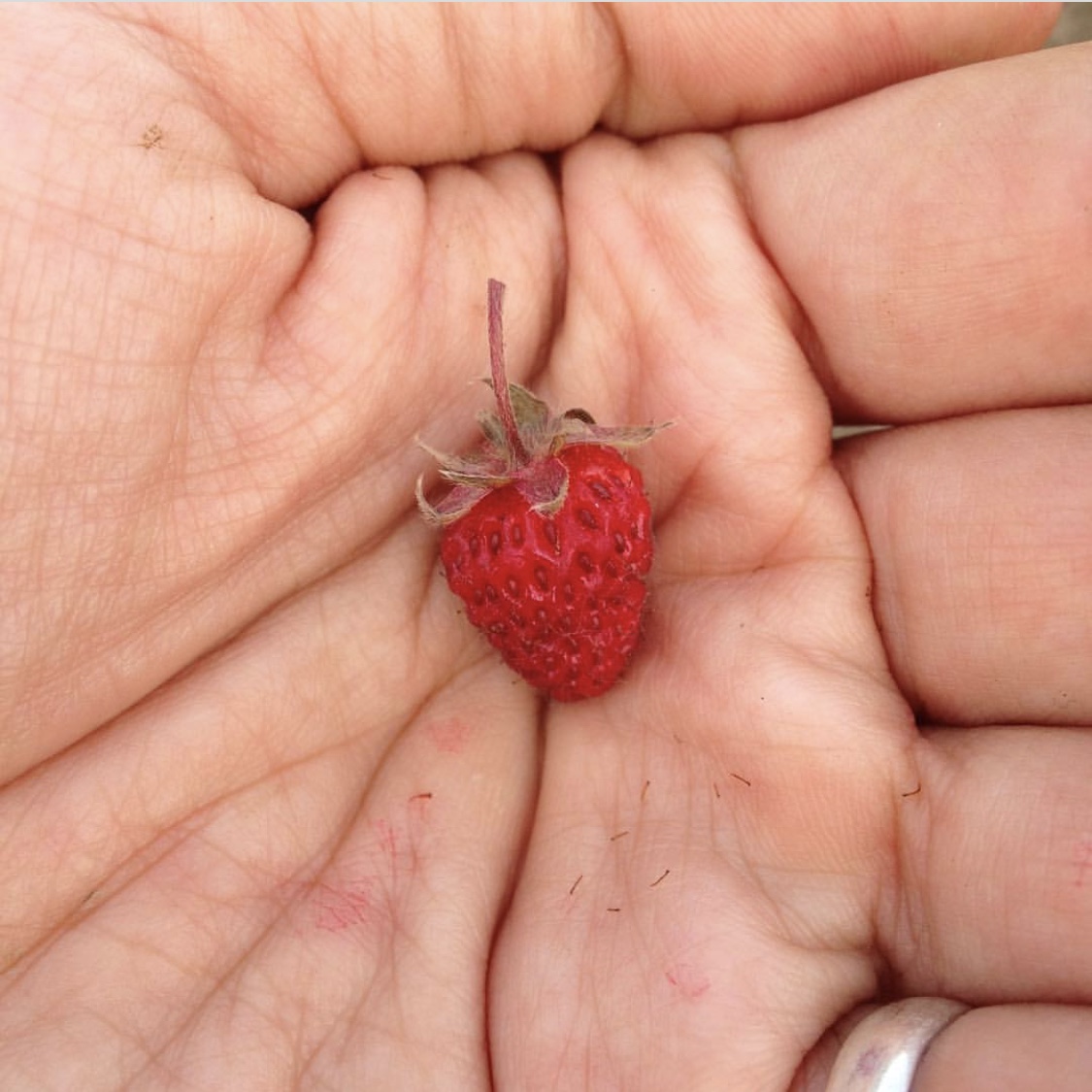Eastern woodland edible and medicinal plants that I learned growing up in Vermont
Eastern woodland edible and medicinal plants that I learned growing up in Vermont
Written by Jessica Dolan
Photography by Charlotte Logan, Jessica Dolan, and Rich Holschuh
Sharing stories with one another is a way of making home; learning and sharing plant practices can connect us within one another, and can also help each person come home to oneself, grounding each of us within the landscapes where we live. My name is Jessica Dolan, and I’m an ethnobotanist and environmental anthropologist who has been working with North American Indigenous communities since 2007. When I was pregnant with my daughter, I had a dream of being in the ground looking up at carrots and turnips growing in a garden above me. I took that as a message that it was time to write to my daughter about the very first plants that I learned as a child. While pregnant, I daydreamed of teaching her about plants, visiting them in their homes, and exploring the gifts and contours of land and water in Vermont together. So, I wrote out my memories of the first plants I learned as a girl in Vermont. Ethnobiologists have studied children’s acquisition of plant knowledge across cultures (see, for example, Hunn 2002). In this piece, I share some of the very first plants I learned as a child, and how and where I learned them; my acquisition of plant knowledge growing up in Vermont is reflective of and was situated within an outdoors and landscape-based, rural culture of Vermont children in the 1980s.
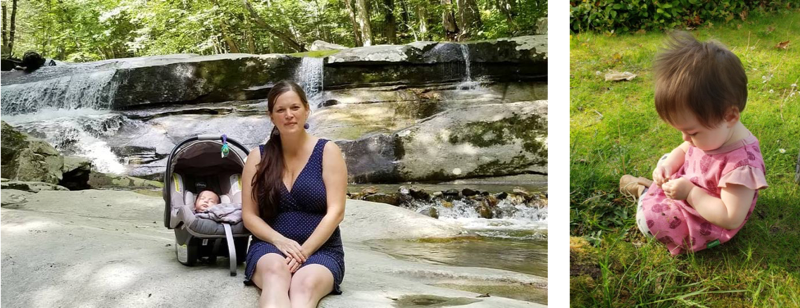
My daughter having a rest beside Stickney Brook in Vermont when she was a baby; getting to know moss in Vancouver at the 2018 Society of Ethnobiology Conference.
As I began to write this, I was sitting in a café, gazing at the Connecticut River, a long river system that runs from northern New Hampshire along its border with Vermont, all the way down through Connecticut to the Atlantic Ocean. Rising like a mirage above the Connecticut, as it has for tens of thousands of years, is Mount Wantastiquet, a mountain that is both an iconic backdrop, and a compass to my small hometown of Brattleboro, Vermont. These natural bodies, and their forests, adjacent wetlands, corn-planted sandy floodplains, and meadows, have been great teachers and places of joy and grieving, adventure, learning, and the sacred for thousands of years, long, long before European settlers populated the landscape. I thought about how, like me, all people growing up in this place that became the town of Brattleboro have witnessed the seasonal changes of all of these landscape features for our entire lives, generation after generation. My first climb of the iconic Mount Wantastiquet was when teachers at our small elementary school took us on a kindergarten expedition. I was fortunate enough to attend an outdoors-based holistic elementary school. Our teachers regularly took us into the forests, fields, and to climb mountains. These dedicated elementary school teachers and my Ma were the first ones to show me how the mountain and the rivers are alive and are ancient friends. Seeing rivers, mountains, plants, animals and tadpoles as persons inculcated an awareness that I am just one person in a long continuum; generations before ours have gotten to know these landscapes, and subsequent generations will, too.
People become emotionally and physically rooted within specific landscape places by learning plants, animals, rock formations, and water systems of that place throughout their upbringing. This growth and learning creates attachment and identity. My Ma used to tell me that a big part of our culture is Vermont, not in a state boundary or political sense, but because of all the plants, foods, animals, birds, fish, rivers, brooks, forests, mountains, meadows, and other outdoor places that surrounded us there. I believe that much of the Vermont "folk" knowledge of plants that was so strong in my upbringing is actually Indigenous knowledge that was transmitted orally through generations of Native people and settlers, and later studied by scientists. It is knowledge that the Western and Eastern Abenakis, Mohicans, Mohawks and other Native people shared with French, English, Irish, Scottish, and African newcomers, and then all the other people who have ever lived or traveled in Vermont, bundled together, passed through centuries and generations into the present collective “local” knowledge.
A close friend from a Mohawk community once shared some traditional philosophy with me: "If you ever feel stressed, overwhelmed, if you ever miss your mother, talk to Mother Earth. She is your first Mother. What are the practices that ground you?" Right away I thought about plants, which brought a smile to my face. So, when I get stressed out, or sad, I turn to the plant practices I learned growing up. Thinking of them, visiting those plants by walking on the land and by the water, and harvesting and preparing them into teas, foods, salves, vinegars, and tinctures, brings me strength, peace, and joy. It is true that land-based learning and healing works. Connecting with other species, such as the plant and fungi kingdoms, are profound intergenerational learning practices for caretaking oneself and one’s community. When those lessons involve making food, teas, salves, crafts, and vinegars together, they are also a lot of fun! Here, I will share with you some of my formative plant relationships that began when I was a child, that continue to ground me and bring me home.
Watercress (Rorippa nasturtium-aquaticum; Nasturtium officinale)
My earliest memory of an edible plant is of collecting watercress from a brook in Belchertown, Massachusetts, where my Ma and I lived just before we moved to Vermont. I must have been about four years old. My mother had shown me what watercress looks like, growing in a mat on the bed of a sparkling, rocky brook. I would walk across the back yard, down into the little brook, and pick some. We made watercress sandwiches with mayonnaise and white bread. Watercress is alive, tasty, and a friend, growing and waiting there, for people to go visit, to enjoy the leaves and stems in a nice peppery sandwich. Watercress greets you with its leaves as creek waters move through it.

Photos: the internet
Watercress is a member of the Brassicaceae, or mustard, family; it can be collected when it is large enough throughout the year -- even sometimes in the winter, if it is a mild winter, and the running water in which is grows is not frozen. It grows delicately from its short mat, up from gently moving water, sometimes in small clumps, sometimes into carpets. It has a spicy taste, and is full of all the nutrients for which the Brassica family is famous; watercress is a wonderful way to "get your greens" in salads, sandwiches, juices, and smoothies; it's packed full of nutrients, and "cleans" your blood (which means that it supports your liver, too). Make sure if you are going to collect watercress that the water from which it is collected is clean and uncontaminated; watercress loves to grow in springs, and it's best to harvest the leaves that grow above the water. An introduced species to North America from Europe and Asia, it has been consumed as a green for centuries.
Milkweed (Asclepias syriaca)
The second plant that captured my imagination was milkweed, of the Asclepiadaceae, or milkweed family. By this time, my Ma and I had moved to Brattleboro, Vermont, and I was attending a small, outdoors-based elementary school near a reservoir area, which is part of a trail system in Brattleboro. The reservoir was on the edge of the forest, yet up the hill from it was a big meadow, with tall grasses, and intermittent young white pine trees. We kids used to play tag up in this meadow, laughing and teasing if we stumbled upon one of the cow pies that remained from when cows were taken to pasture there. Milkweed also grew throughout the meadow, reaching above the soft grasses like downy pod-flags.

Photos: Charlotte Logan and Jessica Dolan
Fresh milkweed pods were pure magic to me. I can remember peeling the green skin open to reveal what looked like a wing covered with brown scales (which are the seeds). Upon peeling back the seeds, the most beautiful white silk is revealed. As a little girl, I fantasized that I would have a whole gown made out of that silk, with the seeds at the base hem of the gown. In the center of the silken threads lies what looks like a bone of a wing! What I did not know then, which I learned several years ago from a friend at the Onondaga Nation, is that milkweed is an important food for humans, as well as insects. My friend taught me to collect milkweed greens at the beginning of the summer. You can harvest the top leaves, flower buds, and apical stems, and steam them or cook them like greens. We harvested a bagful, giving some first to a couple of elders in the community. Back at home, I sautéed them with garlic and olive oil to eat as a vegetable. I have also seen milkweed buds pickled and used like capers. Both leaves and buds must be collected before the buds open into the milkweeds' stunning, fragrant, composite globular flower heads. Milkweeds, many of which are native to North America, are also very critical foods for monarch butterflies. For this reason, people have recently been making efforts to plant species of milkweed in their gardens.
Wild strawberries (Fragaria virginiana)
I first encountered these treats on a sunny meadowed hill in Brattleboro, their red runners woven in through the grassy ground cover, their fuzzy stems, tiny seeds, white flowers with yellow centers, and dark green leaves. Wild strawberries, who belong to the Rosaceae or Rose family, are small sweet treasures hidden in meadows of soft grasses. Finding ripe wild strawberries and eating them right there, on the spot, is like eating sunshine. Wild strawberries are found in fields, and at the edges of woodlands in clearings; they ripen in very late spring, just before summer. It is for this reason that the Haudenosaunee call the tiny wild strawberry, “the leader of the berries,” because it is the first in the year to ripen. In their book about wild edible plants of the Northeast, Fernald and Kinsey (1943) recount families making jam out of wild strawberries. These tiny strawberries are native to North America and crossed with another Fragaria species to produce commercial strawberries. If you find a patch that is quite abundant, both the fruits and the leaves can be made into a tea, good for urinary tract, kidney, and women's reproductive health.
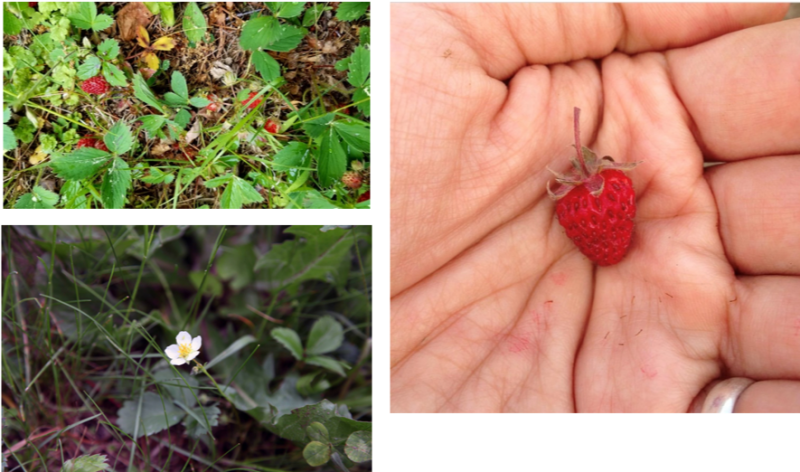
Photos: Charlotte Logan and Jessica Dolan
Sourgrass (Oxalis stricta) and Pineapple weed (Matricaria matricarioides)
When I was a little girl, as I would wait for my parents to pick me up from school, sitting on a grassy hill in shaded at the top by pine trees and with a dirt parking lot at its base, I would amuse myself by finding snacks in the grass to eat. I would do this with wild strawberries that grew on the hill, but also with two other plants I learned early on, that grew from the sandy, rocky driveway: pineapple weed and wood sorrel / “sourgrass.” Pineapple weed, native to North America and Northeastern Asia, is a member of the Asteraceae family, which is the family famous for daisies and sunflowers. Wood sorrel is from the Oxalidaceae, or wood-sorrel family; it is an introduced European cousin to the native Oxalis species of North America. Both plants grow in sandy, often disturbed soils, like those found in schoolyards. I remember lying down on the pavement to look at these plants, growing out of rocky areas, at plant's-eye-level. Pineapple weed stands out because it looks like little pineapples but smells sweet like chamomile. Indeed, it is possible to make a delicious tea out of its flower heads and leaves! Other kids who I grew up with called wood sorrel "sourgrass," as we grazed on it at recess, or after school. Wood sorrel may be one of the shamrocks of Ireland (along with clover); its leaves form a trifecta composite of heart-shaped leaflets. Its seedpods look like tiny little okras, and its flowers are bright yellow. We used to clasp the base of the plant with our fingers, and run them up the stems, shaving leaves, flowers and seed pods off, to eat them all at once. They all have a delicious, sour taste that contribute great tangy flavor when sprinkled in with other greens in salads. But eat only a little bit: Oxalidaceae plants contain oxalic acid, or oxalates.
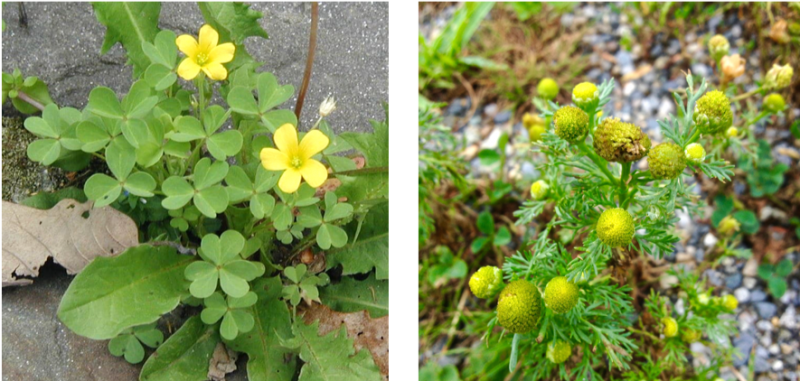
Photos: the internet and Rich Holschuh
Wintergreen berries (Gaultheria procumbens)
My best childhood friend first taught me to find and eat wintergreen berries when we played in the woods on Putney Mountain; they also grow on Mount Wantastiquet and in other mixed hardwood-coniferous rocky woodland habitats. Delicious wintergreen, or eastern teaberry (of teaberry gum fame), belongs to the Ericaceae or Heath family, and is native to North America. The Ericaceae family is full of berries we know and love, such as cranberry, blueberry, crowberry, and more. Wintergreen is a woodland plant that grows in pine-hardwood-hemlock forests, with alternate ovate leaves, pink to bright red berries, and a connected root system underground. The leaves when crushed smell minty. You will find them ready to harvest from fall to early spring. They have a friend, the partridge berry (Mitchella repens), that often grows nearby, and is a look-alike. You will be able to tell the difference, because Partridge berries have smaller, shiny green ovate leaves along runners; each berry has what looks to be two eyes on its underside, and they do not taste or smell like wintergreen. Wintergreen berries can be eaten in small quantities as a snack; the plant contains methyl salicate, which is what is in Aspirin, so proceed with caution. The berries and leaves can be made into a tea by pouring water over them and steeping them overnight or for 48 hours. Add sparkling water to this tea to make wintergreen soda.
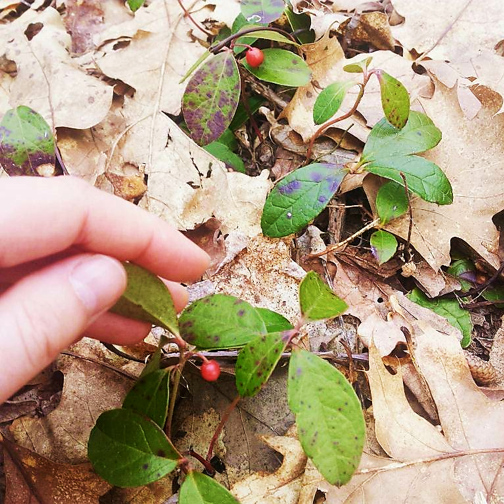
Photo: Jessica Dolan
Jewelweed/ touch-me-not (Impatiens capensis)
This wetland and riverbank plant that grows in sandy and clay soil was another source of fun when we were young. If you touch the seed pods when they are round enough to release, you can launch the seeds at your friends! This exploding seed-dispersal technique of Jewelweed has also given the plant the name of touch-me-not. Spotted Jewelweed (Impatiens capensis), belongs to the Balsaminaceae, or Touch-me-not, family, and is a native species to North America. It has light to deep orange flowers, tall, spindly, succulent-like stalks with viscous insides, leaves with beveled margins and the distinguished characteristic of sparkling like jewels when adorned with beads of water. Jewelweed is a wonderful plant to know, because it is a medicine for the allergic-reaction producing plant it often grows right beside: poison ivy (Rhus toxicodendron). There is a saying that I learned from ethnobotany field work in Ireland that, "The poison grows beside the cure.” This wisdom means many things throughout social and ecological worlds. In this case, it's true: both Jewelweed and Poison ivy grow near riverbanks and in other wet places. If you contract poison ivy, you can break open the slightly fleshy, nodular stems of jewelweed and rub the viscous side of the stem on your skin that were exposed to poison ivy. Jewelweed will soothe and perhaps help heal the allergic rash. You can also make a salve out of jewelweed, by decocting the stems, and then combining the concentrated liquid with melted beeswax and Aloe vera, to have on-hand as a remedy for poison ivy.

Photos: the internet and Rich Holschuh
Black raspberries, or black caps (Rubus occidentalis)
I have a most tender memory of my Ma serving me black raspberries in a small dish with cream, the bright summer sunlight streaming into our old Vermont home. But, of course, they can be used in any dessert - pancakes, breads, teas, and more. These Rosaceae-family berries, native to Eastern North America, are my most favorite fruit. Finding and eating them straight away or enjoying them after bringing them home in baskets, tastes like the most heavenly dessert and richest medicine at the same time. Black raspberry bushes can be found at the edge of forests and clearings; they also like to grow where there have been fires. Two defining characteristics of black raspberry bushes are that the undersides of their leaves are silvery, and when you scratch their silvery stem with your nail, it is green beneath. Take care of their sharp thorns when you are harvesting them.
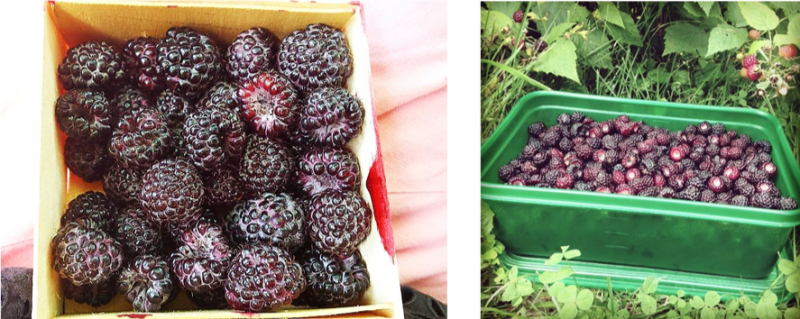
Photos: Jessica Dolan and Charlotte Logan
Red clover (Trifolium pratense)
My first memory of learning this plant was discovering that I could, one by one, pull out each part of its flower (which is really a composite flower) and eat or suck on the base of each. I am not sure who taught me this as a child, but I remember that this was another recess and outdoor-time sweet treat: red clover flowers taste like the honey bees make from them. Now, as an adult, I harvest red clover blossoms and the top leaves to dry them for tea. Red clover, a member of the Leguminoseae or bean family, likes to grow in meadows. Red clover tea is an excellent, mild, nourishing tea for women's reproductive health, for digestion, as a preventative for cancer, and for the liver and blood. It can also be decocted and blended into syrup with elderberries as a remedy for coughs and colds. Red clover is native to Europe, Western Asia, and North Africa, a favorite food for honeybees, and a nitrogen fixing plant.

Photo: Jessica Dolan
Staghorn sumac (Rhus typhina)
I remember my Ma teaching me about this one when I was little. She told me -- to my great amusement -- that the drupes of flowers on this tree are called "catkins." As a child, I thought this was hilarious. Sweet staghorn grows in sunny places, that are often also wet (e.g. along rivers and by roadside ditches). This beauty is another plant native to Eastern North America from the Anacardiaceae or cashew family. You can make delicious lemonade with staghorn sumac that is full of vitamin C! If you do so, take care that you try just a little at first to notice your body's reaction. Although safe and nutritious, sumac is from the same family as poison ivy and other plants that commonly irritate human skin and mucus membranes. Harvest the sumac catkins in the end of July or early August or whenever the berries are vivid red; when you harvest the catkins, you will smell a lemony smell right away. Break apart the catkins and crush the berries in a pitcher or jar full of cold water. Place that mixture in the refrigerator overnight, so the flavor can infuse. When you are ready to drink your sumac lemonade, strain the berries and furry bits out of the liquid. This is a refreshing cold beverage for the hottest parts of summer. Staghorn sumac has a Eurasian cousin, Rhus coriara, which is used as a spice in sauces and dressings, and is an essential ingredient in Turkish za'atar!
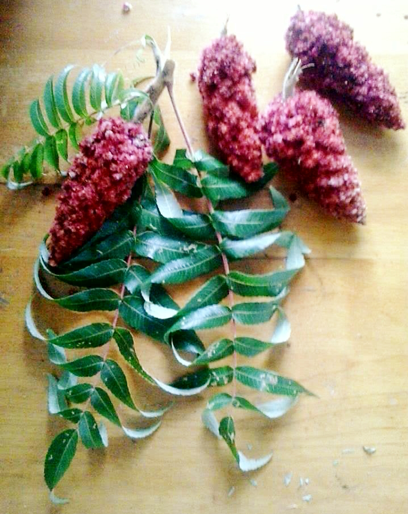
Photo: Jessica Dolan
Crabapple (Malus coronaria)
Lastly, but not least, is the apple that is native to Eastern North America: the sweet or American crabapple. I can remember the pleasurable feeling of stepping on and squishing soft crabapples on the ground. I also remember that boys used to throw these as us when we were children! This year, this fruit was the first plant that my daughter foraged and ate at just over one-year-old! Oh, I was a proud mama! Crabapple, also a Rosaceae family member, can be harvested during the early fall -- apple season. They are full of vitamins and can be made into jellies, compotes, pies, and ciders. Their gestalt, as a tree, is a wind-shaped, slow growing tree, similar to their cousins, the Hawthorns, but with a full crown. Apple and even crab-apple trees are often modified through grafting and coppicing, producing branches of different ages and textures. American crabapple trees have fragrant white flowers in the springtime.

Photos: the internet
All of the plants I have described here are harvested from the late spring through the fall, with the exceptions of watercress, wintergreen, and crab apple which sometime persist through the winter. Milkweed, pineapple weed, wild strawberry, black raspberry, crabapple, staghorn sumac, jewelweed, and wintergreen are native to North America. Watercress, wood sorrel, red clover are introduced species. While humans may no longer depend upon knowing a great number of plants for survival, becoming familiar with local plant allies provides nourishment, medicine, holistic healing, and fun throughout the year.
I hope that reading this ignites your imagination and enfolds your heart within a community of connection between the human and plant beings that populate the earth. Place-based learning, with a sense of discovery and curiosity of how all the species collude to support each other’s lives, imbues the world with wonder -- especially when shared with children! There is something new to learn every season as intimacy with the landscape increases. What used to appear a blur of greens and browns along the roadside, comes into brilliant focus; you will be able to recognize and greet familiar plants and trees as friends. You will know where they live, their habits, how they change through the seasons, and what they offer humans and other living beings. Once you witness how the world is alive and full of personhood in this way, you will see, and can share with the children in your life, that no one is ever alone.
This piece was mostly written during a writing fellowship at the Vermont Studio Center in 2017. I’d like to express my gratitude to the VSC for such a wonderful and supportive experience!
Jessica Dolan, Ph.D., is an ethnobotanist and environmental anthropologist, who researches and writes about human relationships with land, environmental education and management, food security, culturally significant species, and composting. She is currently a Canada-United States Fulbright Fellow in Indigenous Studies at the University of Guelph and is from Brattleboro, Vermont.
Charlotte Logan is a molecular biologist living and working in Syracuse, NY. Aside from her work in the lab, she also is dedicated to learning the language of the Haudenosaunee people, taking pictures of the plants and animals she is learning about along the way.
Rich Holschuh enjoys immersing himself in the landscape where he is planted, the wonderful place known as Wantastegok (Brattleboro, VT). He documents encounters with his relations with his iPhone and is happy to share them with others.
Suggested resources:
Arquette, Mary, Cole, Maxine, and the Akwesasne Task Force on the Environment. 2004.
Restoring our Relationships for the Future. In Blaser, Feit, and McRae, eds. In the Way of Development. Indigenous Peoples, Life Projects, and Globalization. Zed Books: London and New York. Found online at: https://www.idrc.ca/en/book/way-development-indigenous-peoples-life-proj...
Benedict, Salli M. K. 1996. The Naturalized Knowledge Systems of Indigenous Communities. IDRC Reports. April- December. Found online at: https://idl-bnc-idrc.dspacedirect.org/bitstream/handle/10625/22087/112117.pdf?sequence=2&isAllowed=y
Dolan, Jessica M. 2007. “Ochtrinil's Legacy: Irish Women's Knowledge of Medicinal Plants”. In Harvard Papers in Botany, 12(2): 369. Found online at: www.jessica-dolan.com
Fernald, Merritt Lyndon, and Kinsey, Alfred Charles. 1943. Edible Wild Plants of Eastern North America. A special publication of the Gray Herbarium at Harvard University. Idlewild Press, Cornwall-on-Hudson, New York.
Hunn, Eugene. 2002. “Evidence for the precocious acquisition of plant knowledge by Zapotec children,” in Ethnobiology and biocultural diversity. Edited by J. R. Stepp, F. S. Wyndham, and R. K. Zarger, pp. 604–13. Athens: University of Georgia Press.
International Plant Names Index http://www.ipni.org/index.html
Lickers, Henry. 1995. "The Earth is Our Mother" in Akwesasne Notes. Spring (April, May, June), pp. 10 - 23.

